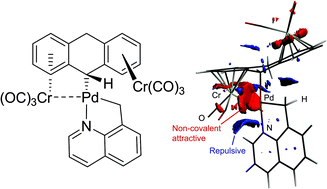New Pd(ii) hemichelates devoid of incipient bridging CO⋯Pd interactions†
Abstract
In organometallic chemistry the commonly known Sidgwick–Langmuir 18 electron rule is constantly being probed for further discovery of molecular compounds that arise as exceptions. The present study examines the formation and the structure of three novel hemichelates of Pd(II) derived from the reaction of in situ-formed indene and hydrophenanthrene-based organometallic anions with three different μ-chloro-bridged palladacycles. Electronic structure and interaction behavior have been calculated with methods of the density functional theory at the (ZORA) MetaGGA-D TPSS-D3(BJ), GGA-D PBE-D3(BJ), and hybrid PBE0-dDsC dispersion corrected levels, all with the implementation of all electron triple zeta single polarization basis set. A particular focus of the theoretical investigation was made on the nature of the interaction between the [Cr(CO)3] moiety and the Pd(II) centers, which according to X-ray diffraction analyses lack significant incipient bridging CO⋯Pd character. Structures were further assessed – Natural Bonding Orbitals (NBO), Quantum Theory of Atoms in Molecules (QTAIM), and Extended Transition State with Natural Orbitals for Chemical Valence (ETS-NOCV) analysis methods. As a result, intramolecular interactions of interest, primarily around the Pd atom, were analyzed as a measure of natural atomic orbital (NAO) contributions to the natural bonding orbital (NBO) formation, QTAIM analysis with special attention to the bonding critical points (BCPs), as well as energetic analysis of intramolecular interaction forces by Energy Decomposition Analysis (EDA). Theoretical analyses confirm that attractive electrostatics dominate the stabilization of Pd(II) hemichelates. In the case of complexes 1c, 2c and 3c we expand the known amount of 14 electron transition metal complexes that can be synthesized via reliable synthetic methods. However, complex 3c presented some means of stability but was more reactive to moisture and air under laboratory conditions and escaped thorough analytical characterization.


 Please wait while we load your content...
Please wait while we load your content...